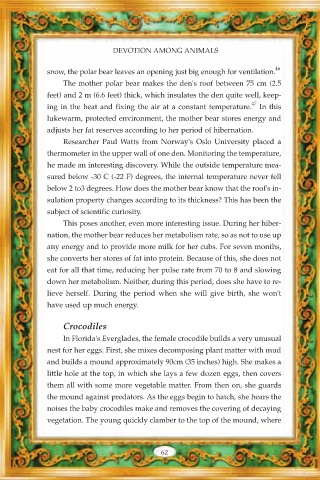Page 64 - Devotion Among Animals Revealing the Work of God
P. 64
DEVOTION AMONG ANIMALS
46
snow, the polar bear leaves an opening just big enough for ventilation.
The mother polar bear makes the den's roof between 75 cm (2.5
feet) and 2 m (6.6 feet) thick, which insulates the den quite well, keep-
47
ing in the heat and fixing the air at a constant temperature. In this
lukewarm, protected environment, the mother bear stores energy and
adjusts her fat reserves according to her period of hibernation.
Researcher Paul Watts from Norway's Oslo University placed a
thermometer in the upper wall of one den. Monitoring the temperature,
he made an interesting discovery. While the outside temperature mea-
sured below -30 C (-22 F) degrees, the internal temperature never fell
below 2 to3 degrees. How does the mother bear know that the roof's in-
sulation property changes according to its thickness? This has been the
subject of scientific curiosity.
This poses another, even more interesting issue. During her hiber-
nation, the mother bear reduces her metabolism rate, so as not to use up
any energy and to provide more milk for her cubs. For seven months,
she converts her stores of fat into protein. Because of this, she does not
eat for all that time, reducing her pulse rate from 70 to 8 and slowing
down her metabolism. Neither, during this period, does she have to re-
lieve herself. During the period when she will give birth, she won't
have used up much energy.
Crocodiles
In Florida's Everglades, the female crocodile builds a very unusual
nest for her eggs. First, she mixes decomposing plant matter with mud
and builds a mound approximately 90cm (35 inches) high. She makes a
little hole at the top, in which she lays a few dozen eggs, then covers
them all with some more vegetable matter. From then on, she guards
the mound against predators. As the eggs begin to hatch, she hears the
noises the baby crocodiles make and removes the covering of decaying
vegetation. The young quickly clamber to the top of the mound, where
62

